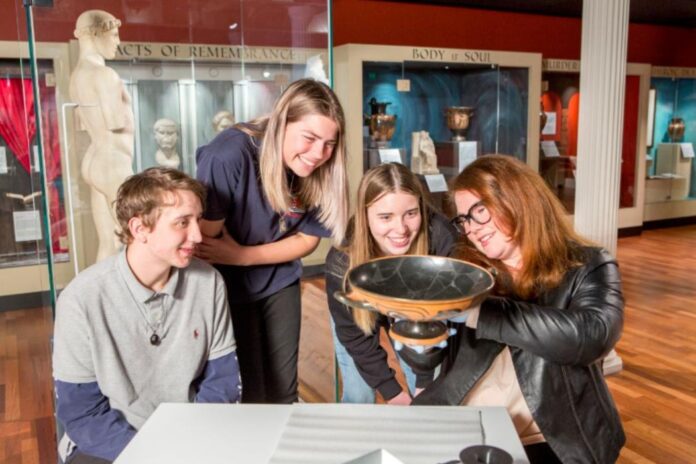Source: University of Canterbury
01 November 2021
Enough visitors to fill the colosseum – that’s how the UC Teece Museum of Antiquities is describing its milestone of 50,000 visitors since it relocated to the Christchurch Arts Centre in 2017.
-
University of Canterbury Teece Museum
The hidden gem was purpose-built to house the University of Canterbury’s James Logie Memorial Collection of Greek and Roman antiquities, including the famous StiltWalker vase – an ancient vessel dating from 540-530 BCE.
“We are delighted that so many members of our community have discovered and enjoyed the fascinating exhibitions and public talks that the museum offers. It is an invaluable resource for our students, researchers and for Ōtautahi Christchurch, and very accessible in this beautiful space at our campus at the Arts Centre,” University of Canterbury Tumu Whakarae | Vice-Chancellor Professor Cheryl de la Rey says. “Congratulations to our dedicated and talented staff and all the student interns and volunteers who make the Teece Museum such a special place to visit.”
Celebrations for the milestone include a special morning tea on 2 November with Ilam MP Sarah Pallett, an outing of the replica chariot to the Riverside Market on 7 November for the public to enjoy, and an online competition that challenged children of all ages to build a model colosseum that finishes on 5 November.
University of Canterbury students complete internships at the Museum, gaining valuable experience working with the collection through the Professional and Community Engagement PACE programme and other internship programmes, and as volunteers who receive credits for their Co-curricular Record.
The Teece Museum gained international attention recently when it matched its fragment of mummy shroud with a fragment in the United States following extensive digital archiving of the collection.
Originally based at the heritage Christchurch Arts Centre for a century, the University of Canterbury moved to the new Ilam campus in the 1970s. In 2017, two of its Arts disciplines, Classics and Music, were relocated to purpose-built facilities back in the Arts Centre. As part of the return to the central city, and with a generous donation from Alumnus Professor David Teece and his wife Leigh Teece, the University of Canterbury opened a permanent public exhibition space for the priceless Logie Collection in the Old Chemistry building.
“After Sydney’s Nicholson Museum, the Logie Collection is the finest Greek and Roman collection in Australasia,” visiting Professor Andrew Stewart of the University of California Berkeley commented during a visit to the museum in 2017.
History of the Logie Collection
The University of Canterbury’s James Logie Memorial Collection began in 1957, with a gift of Greek pottery to Canterbury University College (as the University of Canterbury was then known) from Classics staff member Miss Marion Steven. She founded what became the James Logie Memorial Collection, which is now housed in the University’s Teece Museum.
Marion Steven had a lifelong passion for Greek painted pottery. As a young woman, she enrolled to study Greek and Classics at Canterbury in 1938, and later taught at the University, where she was a popular lecturer, from 1944 to 1977.
In 1950, Marion married James Logie, who was Registrar of the University from 1950 until his death in 1956. In 1957, Marion established the James Logie Memorial Collection as a tribute to her late husband. Since then, the Logie Collection has served to commemorate the great contributions of both James Logie and Marion Steven to the University of Canterbury.
The aim of the collection has been to serve as a teaching and research resource for UC students, academics and interested members of the public. Over the past 64 years the collection has inspired numerous international publications and research projects.
In 2016, the University of Canterbury received a substantial donation to support the relocation the James Logie Memorial Collection of classical antiquities to the University of Canterbury’s Arts Centre campus in central Christchurch. UC alumnus Professor David Teece and his wife Leigh Teece donated funds to support the refurbishment of the old Chemistry building and create the Teece Museum of Classical Antiquities.
Freely available to view in the heart of the Christchurch Arts Centre, the Logie Collection includes vases from Corinth and Athens, the islands in the Aegean, East Greece and the Greek colonies in South Italy and Sicily. The styles represented include Geometric, Orientalising and Corinthian, with emphasis placed on Black and Red-Figure vases from the Archaic and Classical Periods (ca. 600-330 BCE).
A world-renowned expert in Greek art, Professor Andrew Stewart of the University of California Berkeley, who is also Curator of Mediterranean Archaeology at the Hearst Museum of Anthropology visited the University of Canterbury in 2017 as a guest lecturer.
Professor Stewart shared fond memories and a personal connection to the University of Canterbury’s Logie Collection from when he was an academic in New Zealand.
“When I taught in Dunedin in the ’70s, and could get away for a bit, the Logie Collection was my magnet, and its founder and benefactor, Marion Steven, was my mentor,” Professor Stewart said.
“After Sydney’s Nicholson Museum, the Logie Collection is the finest Greek and Roman collection in Australasia.”



